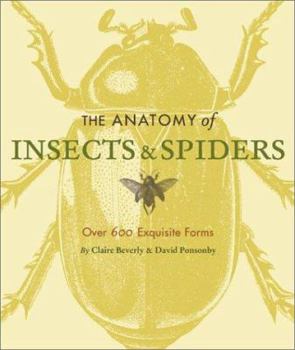The Anatomy of Insects & Spiders: Over 600 Exquisite Forms
Select Format
Select Condition 
Book Overview
The gossamer wings of a dragonfly, the scarlet carapace of the lady beetle, the spectacular shape of the hawkmoth. The insect world teems with exotic forms and inspired renowned devotion in illustrators of the late 19th century. In a volume as jewel-like as its subject, "The Anatomy of Insects & Spiders" presents page after page of select engravings, woodcuts, and drawings from the Victorian era, the golden age of insect illustration. Meticulously rendered, they are paired with observations from early naturalists. The notes may describe the classification of the insect, how its body is constructed, its behavior and preferences, or its habitat. Arranged by insect type and covering all the families from bees and moths to ants and flies, "The Anatomy of Insects & Spiders" reveals detail that is normally seen only under a microscope. A natural for admirers of insect society, this charming volume is both a distinctive introduction and lively armchair companion.
Format:Paperback
Language:English
ISBN:0811839834
ISBN13:9780811839839
Release Date:February 2003
Publisher:Chronicle Books
Length:288 Pages
Weight:1.14 lbs.
Dimensions:1.1" x 5.6" x 6.6"
Customer Reviews
5 ratings
pequeño y util
Published by Thriftbooks.com User , 16 years ago
muy bonito pequeño y útil... tiene buenas gráficas y esta bien explicado,, una buena guía para entomología y estudiantes,, no es a color,, pero es muy bueno
Beautiful engraving-style pictures
Published by Thriftbooks.com User , 18 years ago
It is a wonderful book although smaller than I had originally thought and it only includes the "woodblock" cut style images and very little color. But besides being not what I expected, it is truly a fabulous book and I am more than glad I purchased it. I only wish it were bigger scale so I could examine the woodcuts better. Really incredible.
Pretty to Look At
Published by Thriftbooks.com User , 21 years ago
As a biologist, I get my fill of technical language and new terminology. This book is a welcome blend of art, history, and bugs. The reproductions are very well done and I was suprised at the number and variety of sketch-like prints that were included. Would make a nice gift for a friend who is curious about the natural world.
Nice overview
Published by Thriftbooks.com User , 21 years ago
Great drawings throughout the book. Its technical (as expected from the title being anatomy) but not so technical that you feel like its a lecture. One thing I especially like is that in the descriptions of the insects there is interesting "trivia" that makes this a fun read. Here's a quick excerpt: "the bombardier beetle emits a puff of a volatile chemical, followed by a popping sound, thereby giving it its name. Early naturalists likened this form of defense to humans' use of gunfire."
authoritative without being overly scientific
Published by Thriftbooks.com User , 22 years ago
The Anatomy of Insects admitedly only scratches the surface of entomology, but what it covers is done in exquisite detail. The book begins with a primer on insect anatomy before broadly covering the taxonomy of the major insect orders of beatles, wasps (including bees and ants) termites (including dragonflies and mayflies), butterflies, moths, fleas (and flies), grasshoppers (and crickets), stick insects (including mantises and cockroaches), and spiders.There is little specific information about each species, but plenty of general information about the order, and enough detail to give the lay reader (such as myself) a good "feel" for the critters. However, the diagrams and plates of the insects are what drew me to the book.Many of the pictures are from Victorian era prints, some are more recent etchings, but all are remarkable and beautiful in their own right. (I know, who would have thought of "bugs" as beautiful?) It really is an interesting read, with an excellent biliography for further reading if a specific order or genus strikes your fancy; but the depiction of theses small animals is what makes this book such a treasure.






